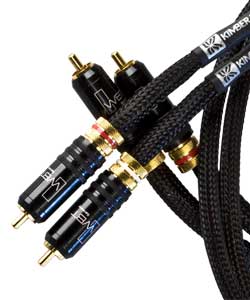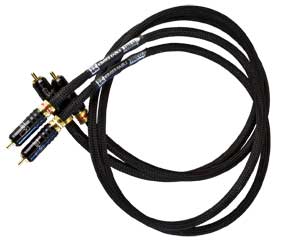 |
|||||||
|
|
|
|
|
|
|
|
|
There is irony in calling the discovery of a 30 year-old company ‘new.’ Surprisingly, considering the 20+year history of TIE, a Kimber product has never been reviewed in either the original print magazine, or here on our new webzine. And since this is our first ever look at Kimber, I think it’s appropriate to start with some back history. Ray Kimber founded Kimber Kable in 1979 after a varied background in live concerts, theater, pro-audio and lighting, and nightclub set-up and design. During this time Mr. Kimber developed an appreciation and curiosity for the role cabling played in the transference of audio, and experimented with ways to reduce the RF interference in the audio signal that was being caused by the lighting & electronics. While experimenting, Ray came up with an idea to counter-rotate multiple sets of conductors in the audio cables in order to cancel out magnetic interaction. What he discovered, however, was that his new braided wire concept not only reduced interference by rejecting the RF noise; it also positively affected the overall sound. Buoyed by these discoveries, Ray thought to take his work further and founded Kimber Kable. His first product was the 4PR speaker cable, which he literally took door-to-door around the U.S. in order to demonstrate the merits of his new design. 30 years later an updated version of the 4PR is still in production, and Ray Kimber & Kimber Kable remain committed to their unique braided wire design. Their current product list consists of a full compliment of audio, video and speaker wire products. The Product Kimber’s catalog includes a vast array of products in all wire categories. Their interconnect lineup starts with the entry level Tonic @ $75.00 for a one meter pair and moves up to the Select KS 1136 @ $2600.00 for a one meter balanced set. The Hero product line falls in the middle of their overall cable line-up and is considered by Kimber to be a more frugal version of their top end Select Line of products. The Hero line utilizes many of the company’s most advanced materials and construction techniques, but in a more cost effective package. Similar to the Select line, the Hero line contains 3 different products: Hero Cu, Hero HB and Hero Ag. The original Hero Cu is an all copper cable that has been available since 1997. The two newer cables, the hybrid copper & silver Hero HB, and the pure silver Hero Ag, were released in 2008. All three products utilize Kimber’s patented Gyroquadratic® braid. For the hybrid HB model, Kimber uses silver in the signal path and copper for the return, combining the improved conductivity of silver without having to bear the full cost of pure silver wiring. All 3 sets in the Hero line are available as either balanced or singled ended, with multiple termination options available. For the review I used the Hero HB RCA interconnects fitted with WBT-0144 Midline RCA connectors. In order to thoroughly test the cable, I set my entire system up with the same Hero HB wire. I used a 0.5m pair to connect the pre-amp (Modwright LS 36.5) and amp (Bryston 9B SST), while 1.0m pairs were used to connect the source components. Source components included the Bryston BDA 1 DAC, a Tom Evans Microgroove phono amplifier, a Bryston BCD1 CD player and a Pioneer Elite DV 58 SACD player.  The Sound The SoundBecause the Kimber wire arrived as I began writing my recently posted review of Bryston’s BDA 1 DAC, I got to spend quite a bit of time with the cables in my system before needing to evaluate them. However, the positive impression made by the Hero HB when I first inserted them into the system has remained, and is still present two months later as I write their own review. What struck me immediately was how clean the music sounded. What I can best describe as air, the sonic space around the upper frequency notes, is as clear as I’ve heard. I like the word air to describe this sonic attribute because it relates not to the notes themselves, but to the space in which the notes exist: where they start, connect, sustain and finally resolve. Whether you are listening to the original note, to the reverb, or to the decay, air is needed for the notes to come alive. With the Hero HB cable the notes exist in open space, without resistance. What is especially pleasing about this characteristic is that it exists without any sense of bite. Cables that excel at high frequency extension often produce a sense of hardness, which can be attractive at first, but over time becomes fatiguing. The Hero HB cable allows the upper notes to hit crisply & cleanly, without any unwanted exaggeration or distortion. While these positive first impressions have remained, with more time a few more attributes began to reveal themselves. I was particularly impressed with the depth and harmonic structure of the entire system when fully wired with the Hero HB interconnects. These attributes were exceptionally evident while listening to Tchaikovsky’s The Nutcracker Suite Op. 71a, from The Royal Ballet Gala Performances conducted by Ernest Asnermet, and during a listen to Ravel’s Bolero, conducted by Charles Munch with the Boston Symphony Orchestra. Clarity was also abundant on a few blues classics, including Muddy Water’s famous Folk Singer and Skip James’ album Today. But the whole package finally revealed itself during two very different listening sessions; the first occurred during a listen to “Nude”, from Radiohead’s In Rainbows; and during “So What”, from side one of the 50th Anniversary edition of Miles Davis Kind of Blue. In fact, the listening experience for the entire Kind of Blue album was as engaging as I’ve ever had – considering the amount of time I’ve spent listening to this famous recording, that speaks volumes for me. Upon a complete evaluation, the highlight of the Hero HB is likely the upper frequency performance. But to be honest, no aspect of the sound has an exaggerated presence, nor is any area lacking. They sound clean, with strong bass performance, almost no sonic signature in the mid-range, and with upper frequency performance that is outstanding. In fact, the Hero HB cables excel in all areas that Hi-Fi components or cables are measured. They perform seamlessly, letting the music through the system without changing its characteristics in any meaningful way. I could continue breaking the listening experience down into technical categories, but after a thorough amount of time with these cables what I enjoy most about their presentation is its honesty. Regardless of the type of music used for the review, the sound was balanced and musical. Conclusion The Kimber Hero HB wire was a very enjoyable product to review. I often found myself setting up for critical listening, only to be distracted by some pleasurable moment when I got lost in the test because I was simply enjoying what I was hearing. Ironically, when evaluating Hi-Fi, forgetting that you are performing a test might be the best outcome for that test! At $575.00 Cdn & $940.00 Cdn for a 0.5m & 1.0m pair, the Hero HB is not a cheap pair of interconnects. However, these cables are definitely a high-value product whose performance, build quality and basic materials more than justify their price. I’ll add that I’ve been impressed with every Kimber Kable product I’ve heard. If you feel that the Hero HB cables are a bit out of your price point I would recommend listening to the Hero Cu, or the Silver Streak. They fall into lower price categories but are still exceptional products in their own right. While my review focused on the Hero HB, I enjoyed listening to all three of these products, and I look forward to continuing to explore more Kimber Kable products in the future. For now though, the Hero HB RCA interconnect cables are a great addition to my system, and are highly recommended.
|
|
| News | Reviews | Commentary | Marketplace | Contact Us | Home |
